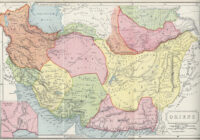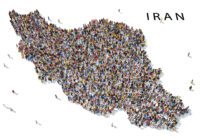While revolutionary protesters espoused diverse ideals and ambitions and worldviews, there was one objective that was almost universal: wholesale opposition to Western political exploitation.
As Vladimir Lenin famously said, “The revolution does not need historians.” The Iranian Revolution of 1979, lacking the old Marxist grandeur of historical necessity, it seems, does. At 40 years old, the revolution has become subject to a rash of analyses, from autopsies to pathologies to prognoses. Fluid, spontaneous and unpredictable, the Iranian Revolution has had a profound and global impact, changing the destiny of Iranians and giving rise to the great adversary the US and its allies face in the Middle East.
To understand the current debate on the 40th anniversary of the revolution, we need to look back at some of the old controversies, notably the one about inevitability: Was 1979 necessary, or was it historically inevitable? Were there moments when a single decision taken another way or a random accident could have altered the whole course of Iran’s history? Was the overthrow of the shah preordained, or was there a liberal alternative to the Pahlavi monarchy in the longue durée?
Revolutionary Energy
The accumulation of revolutionary energy in the build-up to the overthrow of Mohammad Reza Shah Pahlavi seems to suggest that it was both necessary and inevitable. The masses revolted, believing in revolution as a form of social progress and development. Others argue that the shah had placed Iran on the road to modernization, and that liberalism was an eventuality had revolution not stopped it in its tracks.
What can be said with a degree of certainty is that the character, course and direction of the revolution would have been different if Iran’s dialectic with the West had been different. For instance, how would the course of Iranian history have changed had the 1953 coup against Mohammad Mossadegh, orchestrated by Britain and the US, not occurred, and had Mohammad Reza Shah instead worked with the beleaguered prime minister to foster genuine participatory politics? What if the shah had secured his position and legitimacy without Western backing? What if he had not launched a Western-inspired modernization program that entailed marginalizing the clergy? These what-if scenarios all shed light on the question of historical inevitability.
While revolutionary protesters espoused diverse ideals, preferences, ambitions and worldviews, there was one objective that was almost universal — and it was not only the fact that the shah had to go, but wholesale opposition to Western political exploitation. There were those who wed this idea to resistance toward cultural capitulation, which had manifested during the shah’s state-imposed Westernization campaign, a form of “modernization without modernity.” In the two or three decades preceding the revolution, there was a paradigmatic shift in political imagination as Iranian intellectuals began to define their identity by searching for authenticity and by “Othering” the pro-Western Pahlavi state.
Thus, one of the unequivocal achievements of the revolution was Iran’s emancipatory aspirations vis-à-vis the West: independence from Western political encroachment and interference. This idea is firmly built into the conceptual architecture of the regime, showcasing 1979 as a revolt in defense of culture and tradition. This narrative is so potent and commanding that it is institutionalized in virtually every facet of Iran’s political system — from its governing bodies to its vetting agencies, its security apparatus and its religious bodies. It informs the country’s economic outlook, regional and foreign policy, and defines the boundaries of social and civil liberties. It buttresses national affinities and supports the psychological and political roots of the post-1979 national identity. It also provides the ideational and emotive canvas on which hegemonic emotions geared to nationalist activism are explored.
Lessons of the Revolution
What are the lessons of the revolution? Those who speak of the “Iranian soul” ask whether the revolution ruined Iran, while revolutionary romantics and utopians ask whether Iran ruined the revolution. It may be more useful to take a less forensic approach: Rather than looking at the afterlife of the revolution, we can broach the revolution as less abstract and as a lived and living historical experience. The 1979 revolution should not be viewed as a historical dead end or a failed experiment, but rather as a work in progress — with a lot of work still to be done.
While there is consensus on when the revolution began, there is less agreement on when the revolution ends. Again, this has to do with how one perceives history — either as open-ended or as hermetic/closed. Adopting the former, I would argue that at 40 years young (in revolution years), the Iranian Revolution is, at best, a young adult. It is too soon to determine definitively if the revolution will ever achieve the social and political emancipatory ideals of 1979.
What is useful to acknowledge is that the revolution happened and that it is historically irreversible, and that at some stage it will have to start fulfilling the potential that the revolutionaries saw when they rallied for a better system. However, the bulk of the Iranian populace, including the nezam (the ruling establishment), and the diaspora, all operate under the assumption that the revolution might be “undone.” The nezam, fearing regime change, validates this mindset with its firm grip on civil society. The Iranian people cling to the hope of a sudden, overnight change, but no longer US-sponsored, as polls show; far fewer have faith in this option given the US blunders in the region and President Donald Trump’s deleterious policies. And, finally, the diaspora awaits nostalgically for an “end of times” moment, auguring the return to the vatan — the motherland.
Here To Stay
The general academic consensus is that the revolution is here to stay, having weathered many storms: everything from sanctions to erosion of the value of the national currency to terrorism on Iranian soil. There is little likelihood of regime overthrow or foreign military intervention, made patently clear by Trump’s toing and froing on Iran, and by desperate attempts to pressure Tehran through Iran-bashing conferences à-la Warsaw. In view of its revolution and the regime’s durability, it would be an opportune time for state and society to adopt a more dialogical form of engagement, one where there is genuine political evolution. To this end, the first step is a shift away from opposition to the revolution to opposition within the revolution.
Let us not forget that until Mohammad Khatami came to power in 1997, setting in motion a pluralistic momentum, there were no reformist, moderate, centrist, technocratic, principlist or radical categories in Iran’s politics. These labels gained traction and popular usage during and after Khatami’s reform-orientated presidency. Different political forms of organization develop at different stages. The late Fred Halliday reminded us that democracy is not a sudden, all-or-nothing event, and that it took Britain and the US 300 years and three internal wars between them to move from tyranny to the kind of qualified democracy they have now. Perhaps this is the lesson that the revolution itself can learn from its 40 years.
The views expressed in this article are the author’s own and do not necessarily reflect Fair Observer’s editorial policy.
Support Fair Observer
We rely on your support for our independence, diversity and quality.
For more than 10 years, Fair Observer has been free, fair and independent. No billionaire owns us, no advertisers control us. We are a reader-supported nonprofit. Unlike many other publications, we keep our content free for readers regardless of where they live or whether they can afford to pay. We have no paywalls and no ads.
In the post-truth era of fake news, echo chambers and filter bubbles, we publish a plurality of perspectives from around the world. Anyone can publish with us, but everyone goes through a rigorous editorial process. So, you get fact-checked, well-reasoned content instead of noise.
We publish 2,500+ voices from 90+ countries. We also conduct education and training programs
on subjects ranging from digital media and journalism to writing and critical thinking. This
doesn’t come cheap. Servers, editors, trainers and web developers cost
money.
Please consider supporting us on a regular basis as a recurring donor or a
sustaining member.
Will you support FO’s journalism?
We rely on your support for our independence, diversity and quality.






